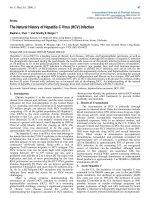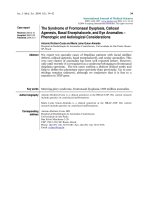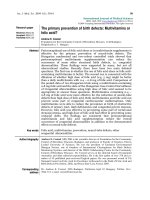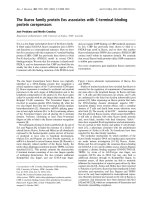Báo cáo y học: "The Influence of Hyperbaric Oxygen Treatment on the Healing of Experimental Defects Filled with Different Bone Graft Substitutes"
Bạn đang xem bản rút gọn của tài liệu. Xem và tải ngay bản đầy đủ của tài liệu tại đây (1.53 MB, 12 trang )
Int. J. Med. Sci. 2011, 8
114
I
I
n
n
t
t
e
e
r
r
n
n
a
a
t
t
i
i
o
o
n
n
a
a
l
l
J
J
o
o
u
u
r
r
n
n
a
a
l
l
o
o
f
f
M
M
e
e
d
d
i
i
c
c
a
a
l
l
S
S
c
c
i
i
e
e
n
n
c
c
e
e
s
s
2011; 8(2):114-125
© Ivyspring International Publisher. All rights reserved.
Research Paper
The Influence of Hyperbaric Oxygen Treatment on the Healing of Experi-
mental Defects Filled with Different Bone Graft Substitutes
Yigit Sirin
1
, Vakur Olgac
2
, Semra Dogru-Abbasoglu
3
, Leyla Tapul
4
, Samil Aktas
5
, Sinan Soley
1
1. Istanbul University, Faculty of Dentistry, Department of Oral Surgery, Istanbul, Turkey
2. Istanbul University, Faculty of Medicine,
Department of Oncologic Pathology, Istanbul, Turkey
3. Istanbul University, Faculty of Medicine, Department of Biochemistry, Istanbul, Turkey
4. Istanbul University, Faculty of Medicine,
Department of Histology and Embryology, Istanbul, Turkey.
5. Istanbul University, Faculty of Medicine, Department of Undersea and Hyperbaric Medicine, Istanbul, Turkey.
Corresponding author: Dr. Yigit Sirin, Istanbul Universitesi, Dishekimligi Fakultesi, Agiz-Dis Cene Hast. Ve
Cerr.Anabilim Dali 34390, Capa/Fatih/Istanbul. +902124142020/30289;
Received: 2010.12.13; Accepted: 2011.01.31; Published: 2011.02.08
Abstract
To assess potential effects of hyperbaric oxygen (HBOT) on artificial bone grafts, β –
Tricalcium phosphate (β-TCP) and calcium phosphate coated bovine bone (CPCBB) substi-
tutes were applied to standard bone defects in rat tibiae. The control defects were left empty.
Half of the animals received 60 minutes of 2.4 atmosphere absolute (ATA) of HBOT. Rats
were sacrificed at one, two and four weeks. Bone healing was assessed histologically and
histomorphometrically using light microscopy. The periosteum over the bone defects was
examined ultrastructurally. Cardiac blood was collected to determine the serum osteocalcin
levels. The HBOT increased new bone formation in the unfilled controls and β-TCP groups
and significantly decreased cartilage matrix and fibrous tissue formations in all groups. Active
osteoblasts and highly organized collagen fibrils were prominent in the periosteum of β-TCP
and control groups. Serum osteocalcin levels also increased with HBOT. The healing of de-
fects filled with CPCBB was similar to the controls and it did not respond to HBOT. These
findings suggested that the HBOT had beneficial effects on the healing of unfilled bone defects
and those filled with β-TCP bone substitute but not with CPCBB, indicating a material-specific
influence pattern of HBOT.
Key words: Hyperbaric oxygen, beta tricalcium phosphate, calcium phosphate coated bovine bone,
light microscopy, ultrastuctural, rat
Introduction
Autogenous bone grafts facilitate natural healing
process by providing adequate amount of mineral
structure, collagen, growth factors and progenitor
cells (1,2). Therefore, it is widely accepted as the "gold
standard" of the bone grafting procedures in the oral
and maxillofacial region. However, creation of a se-
cond surgical site, prolonged operation time, donor
site morbidity, inadequate bone volume and chronic
pain are also associated with clinical complications of
autogenous bone harvesting (3). Thus, several alter-
natives to autogenous bone have been developed
which use a variety of materials, including natural
and synthetic polymers, ceramics, and composites (4).
β – Tricalcium phosphate (β-TCP) ceramics are
bioabsorbable compounds which act as a scaffold for
new vessel and bone formations (5). β-TCP has been
used for alveolar bone and maxillary sinus augmen-
tation procedures as well as the repair of periodontal
and peri-implant bone defects (6,7,8). Another com-
mon bone graft used for similar clinical purposes is
Int. J. Med. Sci. 2011, 8
115
the particle form of inorganic bovine bone which is
manufactured from animal bones. It is ther-
mo-chemically treated in order to extract organic
constituents (9). Both of these materials are potential
alternatives to the autogenous bone in the osseous
reconstructive surgery, especially when smaller graft
volumes are required (10). However, these materials
also share similar disadvantages. Long-term fol-
low-up studies has shown significant histological de-
lays in the replacement of these materials with newly
formed bone tissue, even after six (11) and 12 months
(12). Experimental studies also indicate lower overall
success rate and less bone to implant contact ratio in
dental implants placed in regions which were previ-
ously grafted using aforementioned types of bone
substitutes (13). To overcome these issues, the fabri-
cation of tissue engineered biomaterials, different
combinations of bone grafts and systemic supportive
therapy alternatives are important areas of research.
Hyperbaric oxygen therapy (HBOT) is a mode of
medical treatment in which the patient breathes 100 %
oxygen at a pressure greater than one atmosphere
absolute (ATA) in an entirely enclosed in a pressure
chamber (14). Hyperbaric condition increases the
amount of oxygen dissolved in the blood; therefore, it
can reach areas which are impenetrable for the red
blood cells and provide tissue oxygenation in case of
impaired hemoglobin concentration or function (15).
In Oral and Maxillofacial surgery, HBOT is mainly
used to prevent or to treat radiotherapy associated
osteonecrosis of the jaws (16). In addition, this treat-
ment modality has been found successful in increas-
ing the incorporation rate of autogenous bone grafts
(17) and soft tissue flaps (18), as well as dental implant
success rates (19) in the irradiated mandible.
Although HBOT is considered a valuable ad-
junct on the healing of bone lesions in different ana-
tomical regions with ischemic perfusion, the current
knowledge about its influence on bone graft substi-
tutes used in oral reconstructive surgery is limited.
Therefore, the aim of this study was to evaluate his-
tological and biochemical effects of HBOT on the
healing of normally perfused experimental bone de-
fects filled with β – TCP or calcium phosphate coated
bovine bone (CPCBB) grafting materials.
Materials and Methods
Animals
The experiments were carried out on adult male
Sprague-Dawley rats (N=126) weighing approxi-
mately 250 g ± 20 g, obtained from the Istanbul Uni-
versity, Institute for Experimental Medical Research
(DETAE). All animals were housed in metallic cages
in a temperature (23±1
0
) and humidity (60-80%) con-
trolled room under regular light and dark conditions.
All procedures were reviewed and approved by the
Institutional Animal Care and Use Committee at the
Istanbul University, Institute for Experimental Medi-
cal Research. After several days of acclimatization,
rats were randomly assigned to six experimental
groups, each consisting of 21 rats. Three groups which
will be breathing room air during the experiments
were named as Control, B-TCP and CPCBB. The rest
of the animals who will be receiving HBOT, were as-
signed to Control + HBOT, B-TCP + HBOT, CPCBB +
HBOT groups. The HBOT was planned to be admin-
istered for one, two or four weeks. At the end of each
time points, seven animals from HBOT groups were
sacrificed along with an equal number of rats in
non-HBOT groups. The left tibiae of the rats were
used for light microscopic evaluation and right tibiae
were processed for electron microscopy.
Surgical Procedures
Rats were anesthetized using intraperitoneal in-
jection of 5 mg / kg of Xylazin hydrochloride
(Rompun®, Bayer Turk Kimya San. Ltd. Sti. Istanbul,
Turkey) and 60 mg / kg of Ketamin HCl (Ketanest ®,
Parke Davis, Berlin, Germany). A longitudinal inci-
sion was made along the frontal aspect of both tibiae
and flaps were raised to expose the bone tissue.
Non-critical, four mm circular standard bone defects
involving cortical and cancellous bone layers were
created using a dental burr mounted on a dental ro-
tary instrument under constant irrigation and suction.
The β – TCP (Cerasorb ®,0.5-1.00 μm particle size,
Curasan, Bayern, Germany) and CPCBB (Bio-Cera
®,0,6-1.00 μm particle size, Osteogenic Core Tech-
nologies, Choongnam, Korea) bone graft materials
were placed using an amalgam carrier to ensure that
an equal volume of each material was used for each
rat. Same graft material was used in both legs. The
control defects were left empty. Bleeding was con-
trolled using sterile gauze pads. The periosteum and
the skin were closed using 3.0 surgical sutures. The
left tibiae of the rats were used for light microscopic
evaluation and right tibiae were processed for elec-
tron microscopy.
Hyperbaric oxygen protocol
Half of the rats received HBOT in a cylindrical
mono-place hyperbaric chamber. Following treatment
steps were included in these sessions: 10 minutes of
ventilation to fill the chamber with 100 % oxygen, five
minutes of diving to 15 m (50 feet) in which the rats
were exposed to 2.4 ATA pressure for 60 minutes, five
minutes of re-surfacing and 10 minutes of air ventila-
Int. J. Med. Sci. 2011, 8
116
tion. The treatment started immediately after the sur-
gical procedures were completed. The HBOT was
given every day for one session at 10.00
am
until the
sacrification time points.
Light microscopy preparation and histomor-
phometric analysis
The rats were euthanized and tibiae were ex-
cised. Samples were fixated in 10 % buffered formal-
dehyde solution. Soft tissues were cleaned and the
specimens were decalcified in formic acid sodium
nitrate solution. The regions with bone defects were
further sectioned and embedded in paraffin.
Mid-sagittal serial sections of 7 µm thick were pre-
pared and stained with hematoxylin and eosin. The
histologic slides were examined using light micros-
copy under different magnifications. New bone for-
mation (NBF), fibrous tissue formation (FTF), carti-
lage tissue formation (CTF) was assessed histomor-
phometrically using AnalySIS FIVE® digital imaging
software (Olympus Soft Imaging Solutions GmBH,
Münster, Germany). Sections were observed at X100
magnification and the maximum number of fields in
each region that did not overlap was included.
Means% ± SE% of the mean for each parameter were
determined in each region.
Electron microscopy preparation
The periosteums over the bone defects were
carefully dissected from the surface and the tissues
were fixed in 2,5 % cacodylate buffered glutaralde-
hyde solution for ultra-structural examination and
post-fixed in 1% osmic acid for one hour. The samples
were dehydrated through a graded series of alcohol
and embedded in Epon 812 (Fluka AG, Buchs Swit-
zerland). The blocks were sectioned with LKB Ultra
microtome (Stockholm, Sweden). Thick sections were
stained with toluidin blue examined. Ultra thin sec-
tions selected from appropriate regions were con-
trasted with lead citrate and uranyl acetate and ex-
amined under and electron microscope (JEOL 1011,
JEOL Ltd., Tokyo, Japan).
Serum osteocalcin measurements
1 ml of cardiac blood from the right ventricle
was collected immediately after the sacrification. Af-
ter the centrifugation, the serum portion was sepa-
rated and processed in a rat-specific sandwich ELISA
immunoassay kit (Biomedical Technologies Inc.,
Stoughton, U.S.A.). The amount of substrate turnover
is determined colorimetrically by measuring the ab-
sorbance, which is proportional to the osteocalcin
concentration.
Statistical Analysis
Graph Pad Prism® V.3 statistical analysis soft-
ware (Graph Pad Software Inc., San Diego, CA, USA)
was used in this study. The data was first evaluated
with descriptive statistical methods such as mean and
standard deviation. Kruskal-Wallis test was used for
between group comparison and Dunn’s multiple
comparison tests was performed for subgroups. The
results were evaluated in a confidence interval of 95 %
and p<0.05 was considered as statistically significant.
Results
Clinical Evaluation
The animals healed uneventfully and they con-
tinued their routine physiological activities. During
the experiments, two rats were lost and had to be re-
placed because of the complications of general anes-
thesia. There was no animal death related to post op-
erative infections or HBOT procedures.
Light microscopy observations
In groups which did not receive HBOT, cartilage
matrix formation was dominant both in control (Fig-
ure 1a) and in grafted defects. New bone formation
was observed to start from the defect margins and
extended through the center. At one week, small ne-
crotic areas, mild inflammatory cell infiltration and
scarce new vessel formation were common findings in
all groups. It was found that both materials initiated
foreign body reactions; however, this was more
prominent for β – TCP. There were also fibrous tissue
gaps between the graft particles of the same material.
At two weeks, numerous new bone trabeculae were
observed in the fibrous connective tissue, nearly oc-
cupying the entire defects in the control group. There
was also few scattered cartilage tissue and new vessel
formations. These observations were also visible
around the bone grafts in the experimental defects.
Nevertheless, newly formed bone was more promi-
nent in the CPCBB groups than the β – TCP filled de-
fects. Mild but apparent foreign body reactions were
still present for both graft materials. At four weeks, all
defects in the control groups were almost filled with
new bone tissue in spite of the grafted sites. In β – TCP
groups, the residual bone graft particles were sur-
rounded by a combination of newly formed bone and
cartilage tissue. The new bone formation in the defects
of the CPCBB group was more prominent when
compared to the β – TCP.
Int. J. Med. Sci. 2011, 8
117
Figure 1 (a) Endochondral bone formation characterized by abundant cartilage matrix in the histological slide of the
control group without HBOT at one week time point (H&E×100). (b) The histological slide of the control group which
received HBOT at one week time point, the new bone growth and blood vessel formations (arrows) are clearly visible
(H&E×250). (c) Histological appearance of the CPCBB group without HBOT at one week time point, note the arrows
showing new bone trabeculae around the bone graft (H&E×40) (Cm; Cartilage matrix, Nbf; New bone formation, Gm; Graft
material). (d) Light micrography of the β-TCP group without HBOT taken at two week time point (H&E ×100).
In groups which received HBOT, overall bone
healing pattern was similar to non-HBO groups.
However, from a subjective point of view, new bone
formation was occupying larger areas which were
previously filled by cartilage and fibrous connective
tissues in groups which did not receive HBOT. At one
week, there was no prominent inflammatory cell re-
action in any of the three groups. Loose connective
tissue and new bone trabeculae were found together
with small islands of isolated cartilage tissue and
abundant new vessels in the control group and
around the bone grafts (Figure 1b, 1c). At two weeks,
no cartilage or necrotic tissue formation was observed
in the control group. Moreover, most of defects were
already filled with newly formed bone. Similar ob-
servations were made in the groups in which the bone
grafts and HBOT were used together. There were also
prominent new vessel formations within the connec-
tive tissue surrounding the graft particles (Figure 1d).
At four weeks, nearly all of the fibrous tissue was
replaced by the newly formed bone in the control
group. In β – TCP + HBOT group, there was some
areas of residual graft particles surrounded mainly by
a combination of mature and immature bone. Smaller
areas containing graft particles were also present in
CPCBB + HBOT group, however, the healing of de-
fects in this group were close to that of the control
group (Figure 2, 3 and 4).
Histomorphometry
Fibrous tissue formation: HBOT significantly
reduced the amount of fibrous tissue formation at one
and two week samples of the control animals, as the
respective values of FTV in the Control group was
calculated to be 41,4±14,2 and 29,1±9,2 whereas same
values for Control + HBOT group were 25±12,1 and
14,5±4,1 (p<0.05 for both). Similarly, FTV of the
CPCBB + HBOT group (23,2±10,4) was significantly
lower than CPCBB group (38,4±11,9) at two weeks
specimens (p< 0.05).
Cartilage matrix formation: This value was sig-
nificantly lower in the control + HBOT group (48,1
±30,5) when compared with the controls (13±11,6)
(p<0.05), at one week specimens. Also, the mean CMF
value in the β – TCP + HBOT group (17,1±7,8) was
significantly lower than that of the β – TCP group
(33±15,4) (p < 0.05) at two weeks. At the same time
point, these values were respectively 9,8±4,8 for
CPCBB + HBOT group and 26,4±10,6 for CPCBB
group (p< 0.01) and this difference indicated a statis-
tically significant decrease in the CMF variable in
between these two groups.
Int. J. Med. Sci. 2011, 8
118
New bone formation: Histomorphometric
measurements revealed that the HBOT increased new
bone formation in the control animals, as the NBF
value in the Control + HBOT group (58,5±17,1) was
significantly higher than that of the Control group
(40,2±7,6) (p<0.05) at two weeks. At one and two
weeks’ time points, there was also an increase in the
NBF value of β – TCP + HBOT (18,7±4,7 and 45,7±11,
respectively) when compared to the β – TCP group
(9,2±7,7 and 20,7±7,4 respectively) (p<0.05 and p<
0.01, respectively) (Table 1).
Figure 2 New bone formation and residual graft particles were observed in the histological section taken from the β-TCP
group with adjunctive HBOT at four week time point (H&E×200) (Nbf; New bone formation, Gm; Graft material, Ct;
Connective tissue).
Figure 3 CPCBB graft material which is gradually resorbing and resembles the necrotic bone can be seen in the middle of
this slide. This section has been taken from the CPCBB + HBOT group which was sacrified at four week time point
(H&E×200) (Nbf; New bone formation, Gm; Graft material, Ct; Connective tissue).









